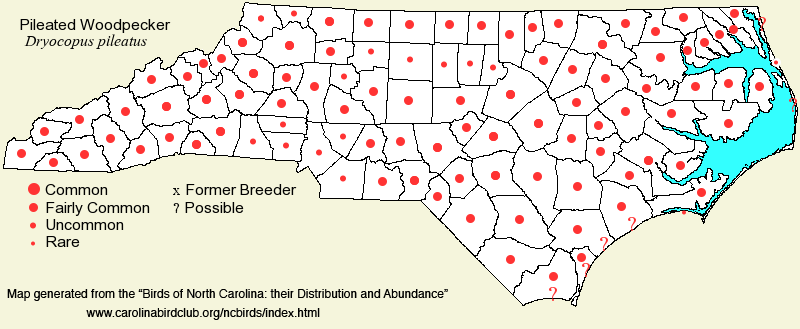 |  |
|
Pileated Woodpecker - Dryocopus pileatus PICIDAE Members: | Search Common: Search Scientific: |
|
|
|||||||
| General Comments | The Pileated Woodpecker is, by far, the largest and most spectacular woodpecker left still alive in the United States, if the Ivory-billed Woodpecker is extinct. And, even though it requires large trees for drilling a nest cavity and for foraging, remarkably it has remained relatively numerous in its range, and perhaps is even becoming slightly more numerous than in previous decades. As with the Red-shouldered Hawk and the Barred Owl, this denizen of extensive and often moist forests has adapted to wooded residential areas, to a point, and it is not uncommon to see Pileated Woodpeckers at bird feeders in the winter. It is strictly non-migratory and is found year-round in mature hardwood or mixed forests, preferably in bottomlands/swamps, but it also is found in upland forests, as well. | ||||||
| Breeding Status | Breeder | ||||||
| NC BRC List | Definitive | ||||||
| State Status | |||||||
| U.S. Status | |||||||
| State Rank | S5 | ||||||
| Global Rank | G5 | ||||||
| Coastal Plain | Permanent resident; essentially non-migratory. Except along some barrier islands (where rare to absent), generally fairly common, to common in some bottomlands and swamps (especially in brownwater systems such as the Roanoke River). Peak counts: ? | ||||||
| Piedmont | Permanent resident; essentially non-migratory. Uncommon to fairly common throughout. Least numerous (uncommon at best) in some of the more heavily populated counties. Peak counts: ? | ||||||
| Mountains | Permanent resident; essentially non-migratory, though there is a downward movement from higher elevations in winter. Fairly common over most of the region, but uncommon as a breeder over 5,000 feet. Peak counts: ? | ||||||
| Finding Tips |
Your best bet is to visit preserves in a floodplain, such as Howell Woods in Johnston, or canoeing along a river such as the Roanoke or Lumber. However, a full day of birding in most areas of the state should turn up the species, though often only a distant bird calling (and not seen). *** | ||||||
| Attribution | LeGrand[2023-03-23], LeGrand[2012-07-14], LeGrand[2011-12-10] | ||||||
| NC Map Map depicts all counties with a report (transient or resident) for the species. | Click on county for list of all known species. |
| NC Breeding Season Map Map depicts assumed breeding season abundance for the species. |  |